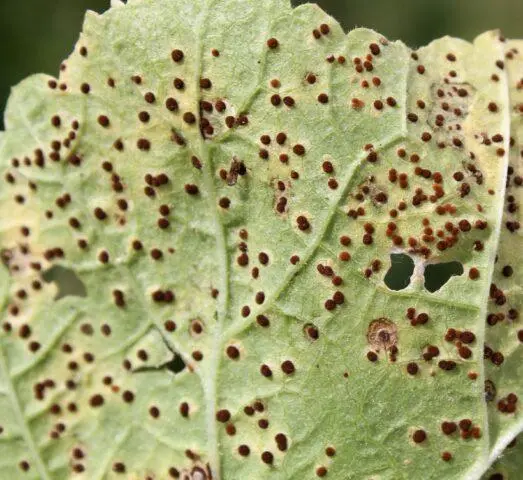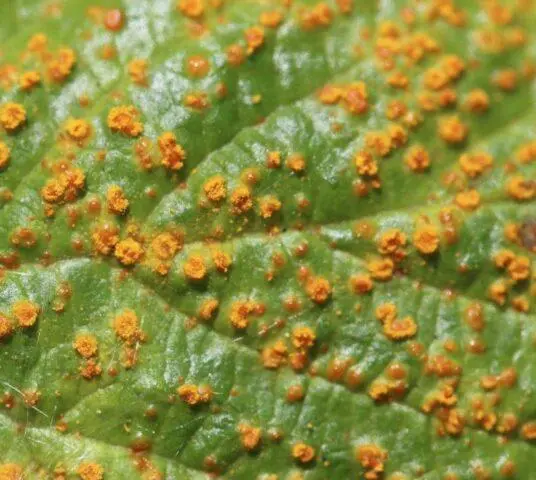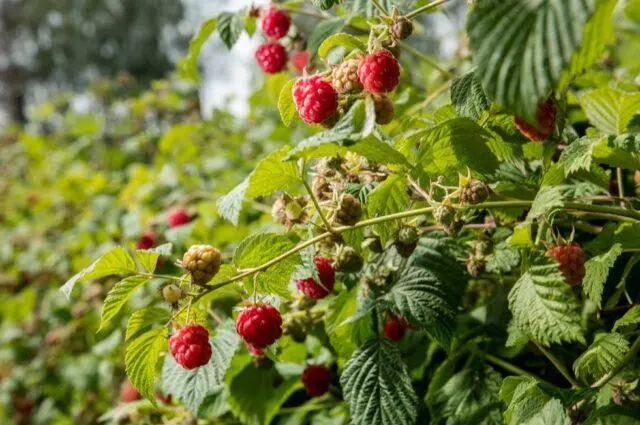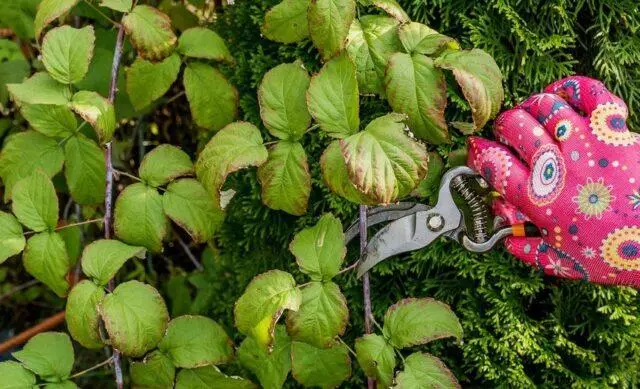Contents
Raspberry rust manifests itself as small rounded spots of bright yellow, orange or brown. This is a dangerous fungal disease that can lead to premature leaf fall, thinning of shoots and general weakening of the plant, which will adversely affect yields. Therefore, if signs of infection are found, it should be immediately treated with drugs or folk remedies.
Description and types of rust with a photo
Raspberry rust is a common infectious disease that is caused by a microscopic fungus from the Rust order of the same name. Pathology is found everywhere, especially in regions with a humid climate – the Black Sea region, the Far East. There are two types of rust – black and white. They differ in pathogens and external signs.
Black
Raspberry black rust is caused by the fungus Phragmidium rubiidaei (Pers). The main stages of the development of the disease:
- In spring, small bright yellow spots begin to appear on the upper part of the leaf. This is a sporulation that resembles small pads.
- Brown balls form on the underside.
- Then they begin to turn black, and after autumn leaf fall, the pest hibernates directly on the foliage, hiding from frost.
You can visually determine the appearance of this type of raspberry rust by numerous yellow dots on the foliage, as well as by premature leaf fall. It is worth considering that the appearance of a pest will have a bad effect not only on productivity, but also on the winter hardiness of the plant.

Signs of the disease can be detected by visual inspection
Orange
Raspberry orange rust is caused by a related fungus called Gymnoconia peckiana. Some signs of the disease coincide with black rust, others differ:
- in early spring, the plant has a lot of weak shoots with deformed leaf plates;
- balls are also formed on the underside of raspberry leaves, but they are not colored brown, but bright orange;
- gradually the affected foliage dries up, begins to twist and falls off already in June.

Foliage affected by orange rust quickly dries and falls off
Causes of appearance
The main cause of raspberry disease is infection with spores of the fungus. Microorganisms parasitize on the foliage and multiply rapidly, as a result of which not only the crown, but also the shoots weaken. Even with proper care, it is impossible to completely exclude the appearance of the disease. It is known that the provoking factors of its development are:
- excessive watering;
- dense plantings (high humidity);
- violation of the rules of care (for example, if you do not remove the fallen leaves of raspberries, this will most likely lead to the fact that the pest will successfully overwinter and will again parasitize on the bushes).
- rainy summer, climatic features of the region.
What to do if there is rust on raspberries
Treatment of raspberry rust is carried out in different ways. The most powerful means are chemical fungicides. They are used only in the early stages of raspberry development, i.e. spring or early summer. They are also effective for prevention.
However, it is dangerous to use chemicals at the fruiting stage – toxic substances can also accumulate in berries. At this time, it is better to use biological preparations. You can also try to treat raspberries from rust with folk remedies. They give good results in the early stages of the disease. Home remedies can also be used as a preventive measure.
Chemicals
The active ingredients of chemical preparations (fungicides) are artificially synthesized compounds. They are very effective in controlling raspberry rust, however they can be toxic. Therefore, it is better to use such funds before fruit set. Moreover, during flowering they should not be used.

Many fungicides are dangerous for bees, so they are not used during raspberry flowering.
Among the best remedies for raspberry rust are the following:
- Bordeaux liquid;
- “Abiga Peak”;
- “Polishing DF”;
- “Cuproxat”;
- “Kumulus DF”.
For example, the consumption rate of the working fluid of the Abiga-Peak preparation is 400 liters per hectare.
Folk remedies
Folk remedies are effective in the early stages of the development of raspberry rust. Their main advantage is the natural composition, the absence of toxic substances. You can use homemade solutions, infusions and decoctions at any time, including shortly before picking berries. The main recipes are listed below:
- Take 10 ml of an alcoholic solution of iodine and dissolve in 10 liters. Raspberries are treated for rust three times every two days.
- They mow, grind the wormwood, fill the bucket to half, fill it with water at room temperature and insist in the shade until foam appears. Then filter, dilute with water five times. Carry out several treatments for raspberries from rust.
- Fill 2/3 of the volume of the bucket with wood ash and pour water, insist under the sun, stir occasionally. As soon as the surface becomes yellowish, the upper part is carefully drained, the rest is diluted with water twice and the raspberries are processed from rust.
- Take five tablespoons (without top) of soda ash and dissolve in 10 liters of water. 100 g of laundry soap shavings are added there, insisted for several hours. Spray the leaves.
- If there is a lot of horsetail growing nearby, it is plucked, cut and filled to half a bucket. Pour water at room temperature to the top, then boil for several minutes, cover with a lid and leave for a day. Filter and, without diluting, proceed to the processing of shrubs.
Agricultural practices
Agricultural practices serve as a preventive measure for raspberry rust. Their essence is to ensure proper planting and care of the shrub. The basic rules are:
- do not plant too thick;
- regularly trim the shrub, thin out the crown;
- remove fallen leaves in the fall;
- periodically inspect the shrub and completely remove the affected foliage (if there is a lot of it, along with the shoot);
- do not plant shrubs in the place where recently (1-2 years ago) there was an old raspberry.
Bad neighbors are strawberries (strawberries), potatoes, tomatoes, eggplants and other nightshades.

A place for planting raspberries must be chosen taking into account which crops grew on it before.
Biopreparations
Biological preparations are based on strains of microorganisms that effectively destroy the causative agent of black and orange rust. At the same time, the products are not toxic, so they are used even at the fruiting stage (maximum one week before harvesting). The main means are:
- “Respecta 25%”;
- «Strekkar»;
- “Phytolavin, VRK”;
- “Abacus Ultra, SE”;
- “Akanto Plus, KS”.
preventive measures
It is much easier to prevent the spread of rust than to deal with the consequences of its appearance. Experienced summer residents have developed several preventive measures that you should pay attention to:
- Choose the right place to land. It should not be located in a lowland – otherwise, after the rains, constant stagnation of moisture will be observed. Also, raspberry bushes are not planted close to buildings or shrubs – in this case there is no influx of fresh air, which also provokes waterlogging and rust development.
- Avoid crowded landings. Even if there is not enough space on the site, it is better to donate an “extra” seedling than to place them close to each other. The minimum distance between the holes should be 70-80 cm.
- In early spring, even before the buds swell, raspberries are treated with any chemical or biological fungicide. Along with it, you can use a solution of urea with a concentration of 8%. This will not only prevent the development of rust, but also serve as a source of valuable nitrogen compounds that ensure the rapid growth of the shrub.
- Leaf litter in the fall should be immediately removed and burned, or simply carried away from the raspberries.
- Periodically, it is recommended to prune raspberries (in late autumn or early spring). This prevents thickening of the crown, which is also useful for rust prevention.
- Follow other care rules that also affect the resistance of raspberries to diseases and pests – weeding, loosening the soil, fertilizing, mulching in summer and winter.

One of the preventive measures is regular pruning of shrubs.
Conclusion
Raspberry rust is a fairly common disease, especially in regions with a humid climate. It is possible to cure raspberries affected by an infection in the early stages. If the disease is running, it is easier to cut off the affected branches and burn them.









